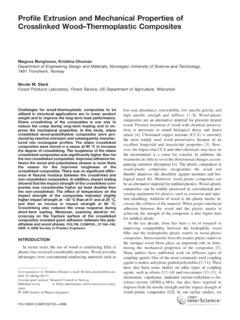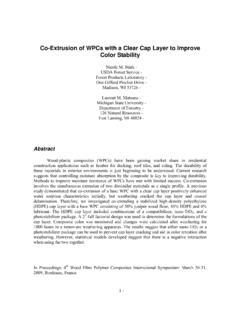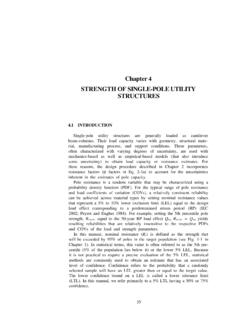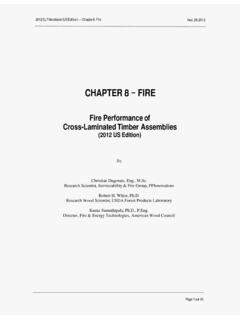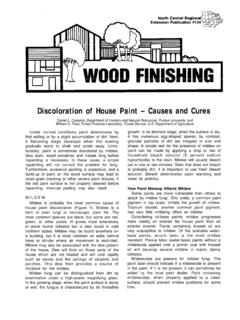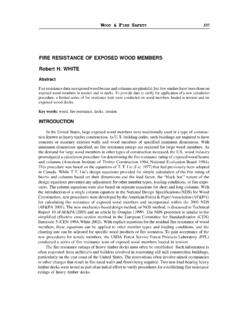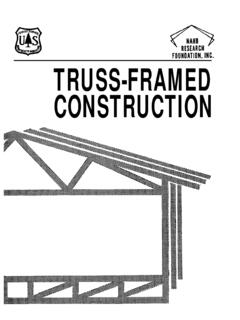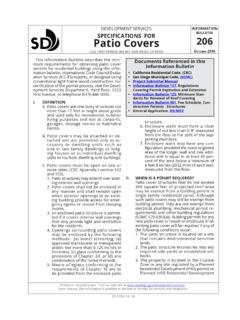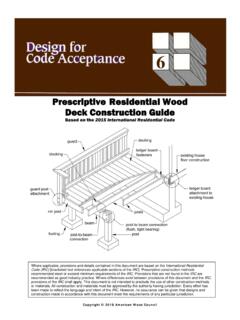Transcription of Standard Specifications for Wood Poles - USDA Forest Service
1 Standard Specifications FOR WOOD Poles Ronald Wolfe, Research General Engineer Russell Moody, Research General Engineer Department of Agriculture Forest Service Forest Products Laboratory Madison, WI 53705 Abstract This committee meets on an annual basis to review andupdateitsstandards. This paper describes the standards for wood Poles preparedbytheAmericanNationalStandardsIn stitute The objective of this paper is to describe the standards (ANSI) Committee05 andthe Committee sactivities in forwood Poles and otherwood products used in utility maintaining the standards. The three standards form structures as well as the ongoing activities of ANSI the basis for purchasing and designing most wood Committee 05 in maintaining the three standards for utility structures in the United States. The round pole wood products used in utility structures.
2 The paper Standard , ANSI , includes Specifications , reviews other pole-related standards, but it places dimensions, and fiber stress values for design. The special emphasis on the role of the ANSI wood othertwo standards, ANSI and , also address pole Standard Specifications . Discussion of topics importantissuesforspecifyingmaterial propertiesand covered by this Standard provides insight to variables deriving fiber stress. The ANSI 05 Committee meets considered intheproductionanddesign ofutilitypoles once a year to provide an open forum for discussing as well as some perspective on the influence of the concerns related to these standards. Standard . Introduction Development of Wood Pole Standards Round timbers have been used as structural members for centuries. At the turn of the present century, the Standards written specifically for the structural developmentofelectricpowerdistributionsy stemsand applications of Poles include those currently telegraph and telephone communications prompted a maintained by ANSI (2-5), the American Society for great demand for Poles .
3 As more people became Testing and Materials (ASTM) (7-10), the American involved inconvertingtreesto utilitystructures, a need Society of Agricultural Engineers (ASAE) (6), and the arose for a common basis of understanding related to Rural Electrification Administration (REA) (15). The form and quality requirements of utility Poles . Pole ASAEandREAstandardsreferenceANSIand/orAS TM producers and users metto discuss concerns related to as the basis for selecting and assigning allowable harvesting, processing, and designing pole structures stresses to wood Poles . The ASTM Standard provides a and to reach some agreement on acceptable limits method for deriving allowable stresses for round related to form and processing of utility Poles . This timbers used as construction Poles , piles, and marine discussion led to the formation of the American structures.
4 The ANSI Standard for wood Poles applies Standards Association Committee 05, which later totransmission and distribution-line applications. became the American National Standards Institute (ANSI) Committee 05 as efforts were made to establish History national standards. The product of this continuing effort isa nationally recognized Standard thatprovides the basis for material Specifications , classification, and Among the first nationally recognized standards for engineeringpropertiesforwood round timbers were ASTM Standard 1915 05 Committee provides a forum forpole producers and Specifications for Round Timber Piles) and the users that enables them to address changing market American Standards Association (ASA) Standard 05, issues and maintain a needed supply of utility Poles . 1924 (Wood Pole Specifications and Dimensions).
5 These standards documented the characteristics that 1 best defined "minimallyacceptable"as it relates to pile life of existing Poles through careful inspection, in-and/or pole applications and laid the foundation for place treatment, or repair. Techniques that can most current standards related to structural use of accurately determine the residual capacity of existing roundtimbers. structures will be in high demand, and these same methods can be used to determine more accurately the Engineering properties ofwood Poles (ANSI ) and properties of new Poles , thus providing a basis for piles (ASTM D2899) are set as a function of species more efficient design and use through alternative and are considered applicable to all Poles that meet methods of assigning engineering properties (13). the minimum quality Specifications .
6 In 1941, the American Association of State Highway Officials ANSI WoodPole Specifications assigned allowable bearing stresses for three primary speciesoftimberpiles: Southern Pine, Douglas-fir, and oak. Thirty years later, ASTM adopted Standard The ANSI Standard covers the Specifications and proceduresforderivingengineeringproperti esfor dimensions for untreated Poles loaded as simple pole species (ASTM D2899). These procedures are cantilevers subject to transverse load only. similarto those used forstress-graded lumber, butthey Specifications for preservative-treated wood utility recognize no within-species qualitygradations. Rated Poles are to be given by the purchaser on the basis of Poles simply meet or exceed minimum quality requirements detailed in other standards ( , AWPA Specifications . At about the same time, the ASA also C4 (12) or ASTM D4064 (9)).
7 Adopted engineering property values for Poles on the basis of information from extensive tests (19,20), while The ANSI Standard includes requirements related recognizing established precedents. Additional data to species, acceptance criteria, manufacturing developed within the past 20 years have expanded the requirements, length andclass, and knowledge of pole strength and are being considered Standard lists 25 species native to the United States that by the ANSI 05 Committee as a basis for developing a are considered to exhibit the physical and mechanical reliability-basedload-resistance-factord esignapproach properties appropriate for use as Poles . Fiber stress to the design of utility-pole structural systems (14,15). values and pole size and shape values are given for each of these species. However, four species have Future Trends been dropped from the AWPA C4 Standard for preservative treatment of Poles because they are seldom used; six other species are noted by the ANSI The primary use of wood Poles in the future will be in Standard as not commonly used.
8 Six of the maintenance ofexisting transmission and distribution remaining 15 species account for 90% of Poles systems. The use of Poles to support telephone and produced and used in the United States. These six local utilitydistribution lines is slowlydiminishing. In species include the four species of Southern Pine that addition to expanding the practice of burying local are grouped and marketed together, Douglas-fir, and distribution lines, telephonecompanies areexpanding western redcedar(Fig. 1). the use of high-frequency, electromagnetic wave technologies to transmit signals over long distances. Surveys taken over the past 10 years have indicated that Southern Pine is by far the most widely used pole Over the past decade, pole production has remained species in the United States (17). Of an estimated steady at 3 million Poles per year.
9 It has been million Poles produced in the United States in 1990, estimated that about 100 million Poles are in use 75% were Southern Pine, 9% 'Douglas-fir, and 6% today. As new markets decline, future pole western redcedar (Fig. 1). The species designated productionwillfocusprimarilyonmaintainin gexisting "other" in Figure 1 include a mix of pines, spruce, lines unless foreign markets are developed. Growing larch, and hemlock. The large number of Southern concern for more efficient use of the Nation's timber Pine Poles is due in part to extensive use of smaller resources as well as the reliability of utility Southern Pinepolesin distribution classes. Inthelarger transmission and distribution systems is leading to a transmission (class H) Poles , Douglas-firand western number of innovations that will affect the wood pole redcedar would make up a larger percentage of the industry.
10 Competing materials (steel, aluminum, total. concrete, and fiberglass) are being used in place of wood. There is also increased interest in extending the 2 An important consideration in the use of different species for Poles is availability. Availability means more than just the number of trees that are currently growing. To be used for Poles , trees must have certain growth characteristics such as appropriate size, straightness,few largebranches,and generallystraight grain. Many of these properties are determined by the environment in which the tree grows rather than by genetics. Trees grown in tight stands normally grow straight and tall with few large branches, as a result of thecompetition forsunlight. Softwoodsdo much better at growing in tight single-species stands than do hardwoods and thus are likely to yield a higher percentage of "pole trees" in a given stand.
